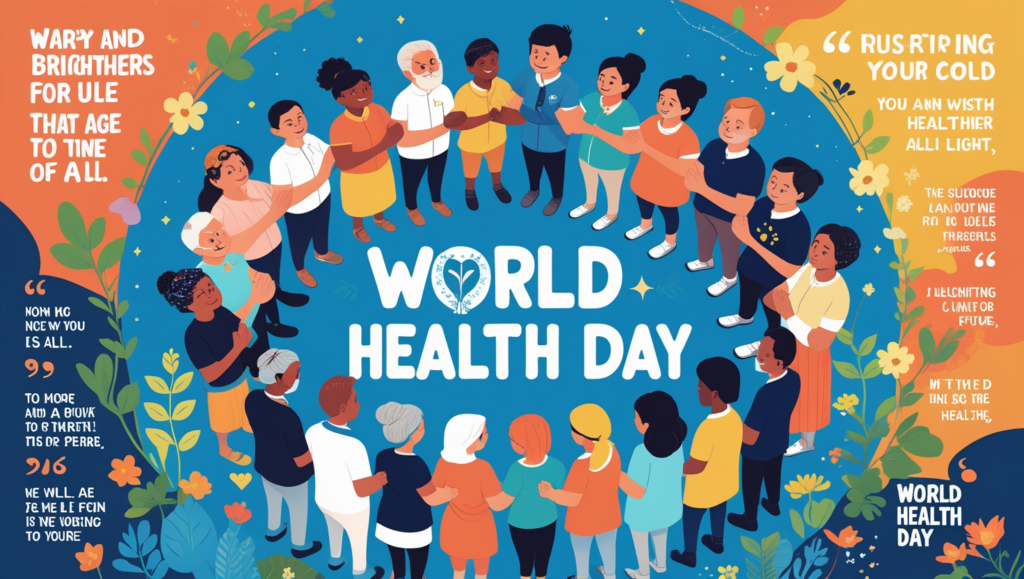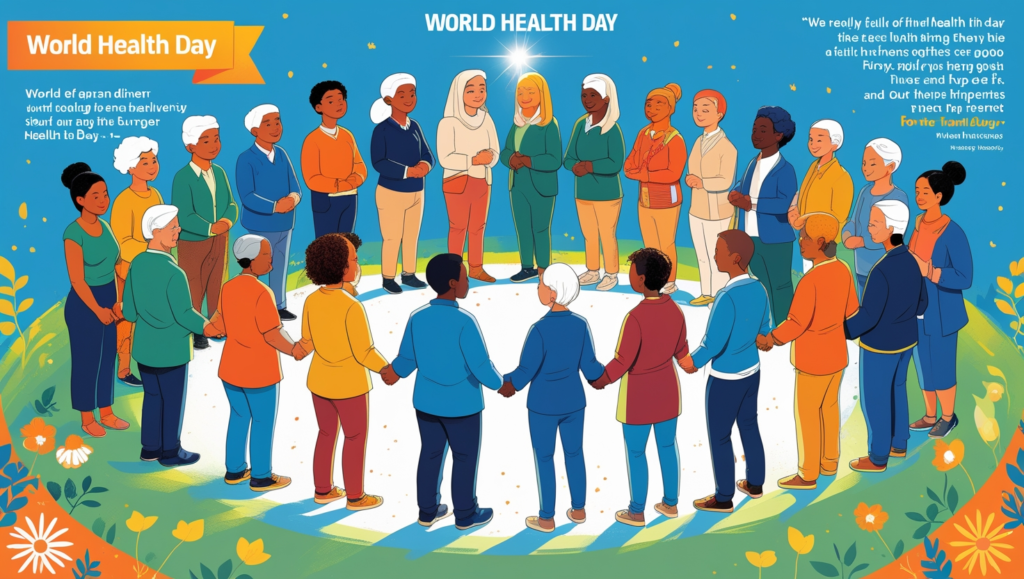Introduction
World Health Day is a special day celebrated every year on April 7, highlighting health issues that matter to people everywhere. Started by the World Health Organization (WHO), it’s a chance to talk about significant health challenges and inspire action to make the world healthier. In 2025, the focus is on “Healthy Beginnings, Hopeful Futures,” zooming in on moms and babies. This article breaks down what World Health Day is, its history, themes, events, and how you can join in—all in simple words and optimized for Google with terms like “World Health Day 2025,” “WHO health campaign,” and “global health awareness.”
What Is World Health Day?
World Health Day happens every April 7, marking the day the WHO was born in 1948. It’s not just a celebration—it’s a call to action. Each year, the WHO picks a theme to tackle a pressing health problem, from diseases like diabetes to more significant issues like clean water or mental wellness. The goal? To get everyone—governments, doctors, and regular folks—thinking and working together for better health. Keywords like “World Health Day meaning,” “Global Health Day,” and “WHO annual event” often lead people to this day’s purpose.
In 2025, the spotlight lands on maternal and newborn health. The campaign, “Healthy Beginnings, Hopeful Futures,” aims to stop preventable deaths of moms and babies during pregnancy and birth. It’s a big deal because, according to WHO, nearly 300,000 women and over 4 million newborns die each year from causes we can fix. This day pushes for better care and support worldwide.
The History of World Health Day
The story of World Health Day starts with the WHO itself. Back in 1945, after World War II, leaders from Brazil and China suggested creating a global health group. By 1948, the WHO was up and running, and its first big meeting—the First World Health Assembly—set April 7 as a day to focus on health. It kicked off in 1950, and ever since, it’s grown into a worldwide event. Search “World Health Day history,” “WHO founding,” or “global health origins” to dig into its roots.
At first, the date was July 22, but they switched it to April 7 to match WHO’s start and get more students involved. Over 75 years, it’s tackled everything from smallpox (which it helped wipe out) to climate change’s impact on health. It’s a day that’s evolved with the world’s needs, making it a key player in global wellness.
Why World Health Day Matters
Why care about World Health Day? Because health touches everyone. It’s not just about doctors or hospitals—it’s about clean air, safe food, and fair access to care. WHO uses this day to share facts—like how four out of five countries are off track to cut maternal deaths by 2030—and spark change. Terms like “importance of World Health Day,” “global health impact,” and “WHO health goals” show why it’s a big deal.
Take 2025’s focus: moms and babies. When they’re healthy, families and communities thrive. But when care is missing, the losses pile up—one death every seven seconds, says WHO. This day reminds us that health isn’t a luxury; it’s a right. It’s a push to fix what’s broken and build a better future.

The 2025 Theme: Healthy Beginnings, Hopeful Futures
Every World Health Day has a theme, and 2025’s is “Healthy Beginnings, Hopeful Futures.” It’s all about giving moms and newborns the best start. The WHO says too many die from things we can prevent—like poor care during birth or not enough checkups after. Starting April 7, 2025, this year-long campaign calls on leaders and health workers to step up. Look up “World Health Day 2025 theme,” “maternal health campaign,” or “newborn survival” for more.
The numbers are stark: 300,000 women and 4 million babies are lost yearly. The plan? Better pregnancy care, emergency help during birth, and support for new moms. It’s not just about surviving—it’s about thriving. This theme ties into the United Nations’ Sustainable Development Goals (SDGs), especially Goal 3: good health.
Past Themes That Shaped the Day
World Health Day’s themes have covered a lot of ground. In 2006, it was about health worker shortages—millions were missing worldwide. In 2014, it tackled diseases from bugs like mosquitoes (think malaria). In 2020, amid COVID-19, it honored nurses and midwives. Each year builds on the last, tackling what’s urgent. Search “past World Health Day themes,” “WHO campaign history,” or “global health milestones” to see the range.
These themes aren’t random—they reflect real problems. The 2025 focus on moms and babies follows years of pushing for universal health coverage (2019) and climate health (2008). It’s a thread of care that keeps growing, showing how health connects us all.
How World Health Day Is Celebrated
On April 7, the world gets busy. WHO hosts significant events—like a global talk on maternal health in 2025, set for 1:30 PM CEST. Cities hold health fairs with free checkups, schools teach kids about wellness, and groups run walks or cleanups. Social media lights up with hashtags like #WorldHealthDay and #HopefulFutures.
You might see a doctor’s talk at a library, a yoga class in a park, or a tweetstorm about healthy pregnancies. It’s a mix of fun and learning, all to spread the word. In 2025, expect stories from moms and health workers, plus tips on newborn care, shared everywhere from TV to TikTok.
Who’s Behind World Health Day?
The WHO runs the show. Founded in 1948, it’s a United Nations group focused on health for all. With 194 member countries, it’s got the clout to make World Health Day huge. Partners like the Pan American Health Organization (PAHO) and local governments pitch in, too. Search “WHO World Health Day,” “global health organizers,” or “UN health efforts” to learn more.
The WHO picks the theme—voted on by its leaders—and sets the tone. For 2025, Director-General Tedros Adhanom Ghebreyesus is driving the maternal health push, backed by experts like Dr. Anshu Banerjee. It’s a team effort to turn ideas into action.

How You Can Join World Health Day 2025
Want in? It’s easy. Share a post with #HopefulFutures or #HealthForAll—maybe a pic of a healthy meal or a thank-you to a nurse. Join an event, like a free health screening, or donate to WHO’s work via the WHO Foundation. You could even host a small talk about the health of the mom and baby with friends. Look up “join World Health Day,” “health awareness ideas,” or “support WHO 2025” for ways to jump in.
Big or small, every step counts. Tell your story—maybe a pregnancy tip that worked for you—or thank a doctor online. It’s about building a wave of care that reaches everyone, everywhere.
The Big Goals: Health and the SDGs
World Health Day ties into the UN’s Sustainable Development Goals, set in 2015 to hit by 2030. Goal 3—good health and well-being—includes cutting maternal deaths to under 70 per 100,000 births and newborn deaths to 12 per 1,000. The 2025 theme is a checkpoint five years from the deadline. Search “World Health Day SDGs,” “UN health goals,” or “maternal health targets” to connect the dots.
Other goals, like clean water (Goal 6) and no poverty (Goal 1), link up, too. Healthy moms and babies need safe homes and good food—health isn’t solo. World Health Day keeps these targets in sight, pushing us closer each year.
Why Maternal and Newborn Health in 2025?
Why moms and babies now? Because the numbers aren’t budging fast enough. WHO says 80% of countries won’t hit maternal survival goals by 2030 at this pace. In places like Latin America, PAHO’s Dr. Jarbas Barbosa Jr. noted one mom died hourly in 2020—a step back after years of gains. Keywords like “maternal health crisis,” “newborn death stats,” and “WHO 2025 focus” explain the urgency.
It’s also smart economics—every dollar spent on maternal care brings $9 to $20 back in healthier societies. Plus, prematurity is the top killer of kids under 5. Fixing this saves lives and builds stronger futures, making 2025’s theme a perfect fit.
Events to Watch in 2025
Mark your calendar for April 7, 2025. WHO’s global event at 1:30 PM CEST (7:30 AM EDT) will stream online—think talks from health leaders and real stories from moms. Local spots might host walks, like a 5K for newborn care or workshops on healthy pregnancies. Search “World Health Day 2025 events,” “maternal health talks,” or “WHO live stream” to find them.
PAHO participates in Americas-focused events after Dr. Barbosa’s 2024 call to cut maternal deaths. Look for webinars, fairs, or even a hospital open house near you—it’s a day packed with ways to learn and help.
How World Health Day Helps Communities
This day isn’t just talk—it changes lives. In Honduras, health volunteers use teleconsults to boost prenatal care. In Pakistan, rural ambulances save moms in labor. These ideas spread on World Health Day, showing what works. Keywords like “World Health Day impact,” “community health wins,” or “maternal care stories” highlight the good it does.
It’s also a megaphone for small voices—moms in poor areas get heard, and health gaps get noticed. When people join in, whether donating or marching, it builds a web of care that lifts everyone.

Challenges World Health Day Faces
It’s not all smooth sailing. Wars and crises—like in 2025’s poorest regions—shut clinics and block supplies, killing moms and babies. Money’s tight, too; aid cuts since 2020 hurt progress. Search “World Health Day challenges,” “global health barriers,” or “maternal care setbacks” to see the hurdles.
Awareness helps, but action is more brutal. Many don’t know their rights to care, and some leaders drag their feet. World Health Day fights these blocks by shouting loud and pushing hard—every year’s a step forward, even if it’s slow.
How It’s Shared: Media and Social Buzz
World Health Day goes big online. In 2025, expect #HopefulFutures to trend with posts from WHO (@WHO) and fans sharing baby pics or health tips. TV and radio—like BBC or NPR—cover it, too, with expert chats. Search “World Health Day social media,” “health campaign buzz,” or “WHO online reach” to catch the vibe.
The WHO releases free toolkits—think graphics and facts—so anyone can spread the word. It’s a global chat where everyone’s invited, making health a hot topic from Twitter to your local news.
What’s Next After April 7, 2025?
The day’s just the start. “Healthy Beginnings, Hopeful Futures” runs annually, with WHO tracking progress—like more clinics or trained midwives. Other health days, like World Tuberculosis Day, keep the momentum. Look up “World Health Day follow-up,” “2025 health plans,” or “WHO year-long campaign” for what’s next.
It’s a relay, not a sprint. Each year hands off to the next, building on wins—like the end of smallpox—to tackle new fights. Thanks to 2025’s push, expect updates on how moms and babies are doing by 2026.
Final Thoughts on World Health Day
World Health Day is a global high-five to health—and a nudge to do better. On April 7, 2025, “Healthy Beginnings, Hopeful Futures” puts moms and babies front and center, chasing a world where no one dies needlessly giving life. It’s simple but huge: health starts strong, and hope follows. Whether you join a walk, share a post, or learn something new, you’re part of it.
This guide’s got it all—history, goals, events, and ways to help. Search “World Health Day full guide,” “2025 health focus,” or “WHO maternal campaign” anytime you want more. It’s a day that proves health is for everyone, everywhere.
References
World Health Organization: www.who.int/campaigns/world-health-day
Pan American Health Organization: “World Health Day 2025 Campaign,” www.paho.org, March 12, 2025.
United Nations: “Sustainable Development Goals,” www.un.org/sustainabledevelopment.
“World Health Day History,” National Today, April 6, 2023.





